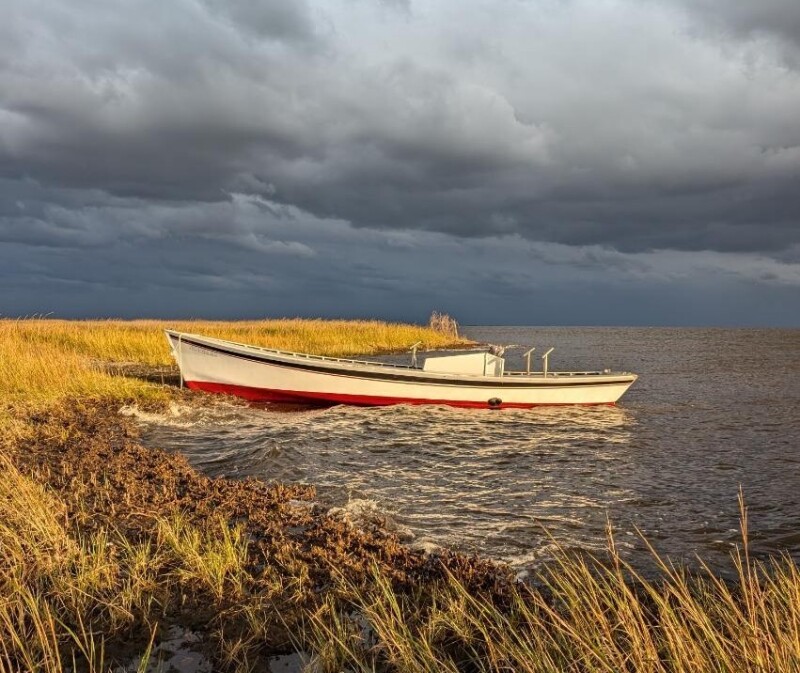Ben Brown of Wanchese, N.C., has a passion for shad boats that goes back to his childhood, which wasn’t so long ago. “I have been studying them since I was a little boy,” says the 22-year-old fisherman and boat carpenter.
Brown’s father bought him an old skiff when he was 12 years old, and he credits that boat with teaching him most of what he knows about boat carpentry. “It was one disaster after another,” he says. “But I learned a lot.”
When he heard his uncle was selling a 1980-built shad boat, Brown went over to the mainland to talk to him. “I told him I wanted to buy it. He had another one he used and hadn’t been using it. So, it was in bad shape. It had some rot in the false deck, and the engine box was all rotted. We made a deal, and I brought it home around June of 2020 and was hoping to have it ready by the 4th of July.”
Brown spent a solid week scraping the layers of old paint off the 30-foot long, and 7-foot-wide boat. “I never want to see the baby blue color again,” he says.
After replacing the rotten decking and building a new engine box, Brown had the boat in the water by late August. “I filled the seams with West System epoxy and fiberglassed the top of the washboards,” he says. “It looked like it had a combing at one time, and I thought about putting it on, but I changed my mind.”
Brown painted the inside gray and the outside white, with a red bottom and a dark blue stripe under the toe rail. He named it the Miss Marsha, after his grandmother. “I think the world of her,” he says.
Last summer, ribbonfish showed up off the coast of North Carolina, and fishermen were getting over $3 a pound for them. Brown took his shad boat out to catch what he could. “Every day I went out there, they’d be talking about my boat on the radio,” he says.
That’s not surprising. The North Carolina shad boat is an iconic part of the Carolina tidewaters. George Washington Creef developed the design in the 1870s, when the shad fishery was going strong — having recovered after a five-year pause during the Civil War. In 1987, the North Carolina General Assembly declared it the Official State Historic Boat.
"From what the old guys tell me, they used to build dugout boats around here, and then George Washington Creef went off on a schooner to Bermuda or the Bahamas and came back with this design,” says Brown.
The classic shad boat carries some remnants of the dugout with a keel that is carved into something of a Y shape with sawn frames fastened to it. The boats have a hard chine and are planked longitudinally. “On mine, the keel comes down and protects the propeller," says Brown. “The shaft sticks out about three inches from the packing gland, and it has a floating rudder that will come up if you run it aground.”
Brown figures his boat draws about 1.5 feet. “It’s 32 feet, but it’ll get in where smaller boats can’t."
In 2023, Brown replaced the 28-hp diesel with a four-cylinder, 80-hp Cummins. “She’ll cruise around 14.5 knots now,” he says.
With one shad boat finished, Brown bought another one to restore: a 23-foot shad boat built in 1928. Again, he’s scraping off baby blue paint.
Boat Specifications:
- Owner: Ben Brown
- Home Port: Wanchese, N.C.
- Builder: Michael Scott
- Hull Material: Atlantic White Cedar
- Year Built: 1980
- Fishery: Built for pound netting and long hauling in northeast North Carolina's Roanoke, Pamlico and Albemarle sounds.
- Length: 30ft
- Beam:7.5ft
- Draft:1.5ft
- Power: Cummins 4b non-turbo, 80hp
- Controls: Morse, hydraulic remote steering
- Power Train: 1.5:1 Borg-Warner Velvet Drive gear, 1.25-inch diameter shaft 8-feet long, 16 x16 propeller, bronze rudder, and bronze rudder-keel connector shoe
- Fuel Capacity: 12 gal
- Top speed: 16 kt
- Cruise: 14.5 kt
- Hold capacity: entire hold above the sub deck of the boat
- Electronics: running lights, forward and aft; inner engine box illumination; inner console illumination; small Garmin plotter.







